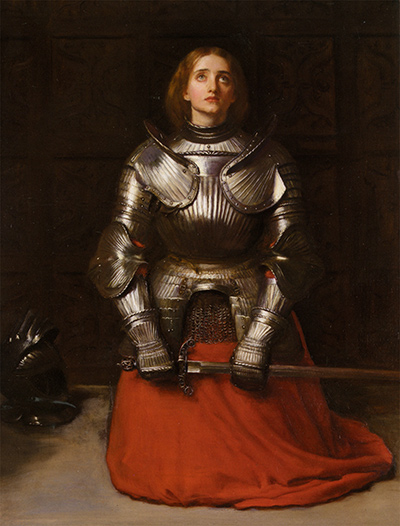Joan of Arc is an oil-on-canvas painting, created by John Everett Millais in 1865. Exuding a powerful, historical theme this work depicts a young girl wearing chainmail and armour over a red skirt.
She is kneeling in prayer but holding a sword in both hands. With her head uncovered, and eyes turned upwards, as to heaven, she has a forlorn look on her face. Millais has captured in this portrait the historical moment when Joan of Arc is encouraged by Saints Michael, Margaret and Catherine to lead the battle against the English.
Her instructions were to seize the city of Orleans, then enable the passage of the French King Charles VII to his coronation at Reims. Unfortunately for Joan, she was captured, tried and committed for heresy by French churchmen. She was then burned at stake by the English in Rouen in 1431.
The dramatic intensity of Joan of Arc is heightened by the way Millais has made the girl dominate the picture in a frontal pose, without surrounding visual distraction. The expertise with which the artist has produced the gleaming texture and highlights on the armour is a testimony to his remarkable skill in this medium.
When this portrait of the admirable young girl with such brave resolution was first shown at the Royal Academy, London a critic from the Art Journal drew attention to the “faithful realisation of steel armour”.
Sir John Everett Millais was born England in 1829. As a young boy, his talent for drawing was recognised by his parents, and they moved to London when he was nine years old. He won the Silver Medal at the Royal Society of Arts for his drawing. At 11-years of age Millais entered the Royal Academy Schools where he won many awards including a Gold Medal in 1847.
A friend of Millais’, William Hunt was developing new ideas influenced by the poetry of John Keats and John Ruskin’s Modern Painters. Along with another friend, Dante Rossetti, the three of them founded the Pre-Raphaelite Brotherhood in 1848.
Two paintings inspired by this new approach were Lorenzo and Isabella, and Christ in the House of His Parents. The latter was exhibited at the Academy in 1850, where it was heavily criticised by Charles Dickens. John Ruskin supported Millais in his work and became a good friend until Millais married Mrs Ruskin - then their friendship was terminated.
In 1852, Huguenot and Ophelia were a huge success, and a year later Millais was elected as an associate of the Royal Academy. The Pre-Raphaelite Brotherhood started breaking up, and Millais’ final two works in this style were Autumn Leaves and Blind Girl, both dated 1856. Neither of these was a great success, however. With a different approach to his painting, The Black Brunswicker became as popular as Huguenot.
Millais was established as a fashionable artist in 1863 when he was elected as a royal academician.
By now Millais had developed a less precise technique with his painting. He would often paint straight onto the canvas with the freedom of an impressionist, and without the careful preparation of previous work. Mrs Bischoffsheim was one portrait that was well rewarded with honours and acclaim at European exhibitions. The subject of another famous portrait named Bubbles was his grandson, but this work gained popularity as an advertisement much to Millais’ disgust.
Towards the end of his life, Millais painted a series of landscapes with a religious theme. Two of these works were entitled Chill October in 1870, and St. Stephen in 1894. Millais was honoured with the title of baronet in 1885. He became president of the Royal Academy of Art in February 1896 and died six months later.




